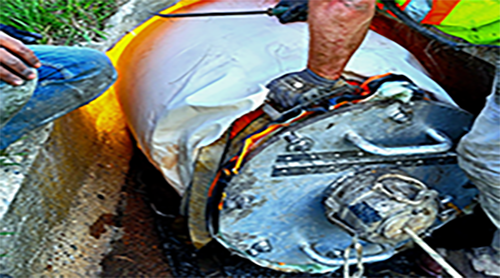
October 02, 2025
This is the second installment in our series where we take a deeper dive into the Top 10 reasons to use ultraviolet cured in place pipe (UV-CIPP). This topic covers both the small construction footprint, along with the environmental benefits as they are closely related.
Infrastructure managers face an increasingly complex challenge: how do you rehabilitate aging underground pipes in densely populated areas, near pristine waterways, or within environmentally protected zones without causing disruption, environmental harm, or community backlash? Ultraviolet cured-in-place pipe (UV-CIPP) technology has emerged as the definitive answer, combining a minimal construction footprint with environmentally safe processes that make it the preferred method for infrastructure rehabilitation in sensitive quarters.
The Modern Infrastructure Challenge
Our nation's infrastructure is aging rapidly. Many systems installed 50-100 years ago are now failing, causing leaks, infiltration, and service disruptions. Traditional "open cut" methods, while straightforward, create cascading problems in today's world:
For projects near lakes, in residential areas, within historic districts, or anywhere else considered environmentally or socially sensitive, these traditional methods often become impractical or even impossible.
UV-CIPP: Two Critical Advantages in One Technology
UV-CIPP technology addresses both the physical and environmental challenges of infrastructure rehabilitation through two interconnected advantages: a remarkably small construction footprint and an inherently clean, safe curing process.
Advantage #1: Minimal Construction Footprint
UV-CIPP is an advanced trenchless rehabilitation technique that uses ultraviolet light to cure a resin-impregnated liner installed inside the existing pipeline. This method eliminates the need for extensive excavation, significantly reducing disruption to surrounding areas.
Access Point Operations: Instead of continuous trenches hundreds of feet long, UV-CIPP requires only small access points—typically existing manholes are sufficient. This dramatic reduction in excavation means:
Compact Equipment Profile: UV-CIPP operations require minimal equipment compared to traditional excavation projects:
This streamlined approach allows UV-CIPP projects to operate in spaces where traditional excavation would be physically impossible—narrow urban streets, congested commercial districts, and constrained residential areas.
Rapid Installation Timeline: The UV-CIPP process works efficiently from start to finish:
UV-CIPP offers numerous advantages including cost savings, minimal disruption to communities, speed, durability, and environmental sustainability, making projects that might take weeks with traditional, “Open-cut” methods completable in days.
Advantage #2: Environmentally Safe Curing Process
Beyond the small physical footprint, UV-CIPP's curing technology provides critical environmental and health safety benefits that set it apart from other rehabilitation methods.
Clean, Emission-Free Process: Unlike traditional thermal CIPP that requires high-temperature steam curing, UV-CIPP uses controlled ultraviolet light to activate the curing process. This fundamental difference creates multiple environmental benefits:
The benefits of UV-CIPP lining include minimal disruption to the surrounding area, shorter cure times compared to other CIPP methods, improved quality control, and enhanced environmental friendliness.
Worker and Community Safety: The clean UV curing process creates a safer environment for everyone involved:
Temperature-Controlled Operation: UV curing maintains ambient temperatures throughout the process, protecting:
Critical Applications: Where UV-CIPP Excels
Lakefront and Waterfront Projects
Infrastructure rehabilitation near water bodies presents unique environmental challenges. Sensitive fish and wildlife habitats along rivers, streams, and connecting waterways have historically been disturbed by traditional, open cut methods. UV-CIPP protects these sensitive areas through:
Physical Protection:
Environmental Safety:
Residential Neighborhoods
Established residential areas require special consideration for both disruption and safety:
Minimal Disruption:
Health and Safety:
Historic Districts
Areas with historic designation face strict preservation requirements:
Urban Commercial Areas
Dense commercial districts cannot afford extended disruptions:
Regulatory and Permitting Advantages
The combination of small footprint and clean process creates significant advantages in navigating complex regulatory environments:
Streamlined Environmental Compliance
Waterfront Projects:
Residential Projects:
Economic Benefits Beyond Installation
While UV-CIPP technology represents an investment in advanced materials and equipment, the total project economics strongly favor this approach in sensitive areas:
Avoided Costs:
Accelerated Timeline Benefits:
Long-Term Value:
The Future of Infrastructure Rehabilitation
As environmental regulations become more stringent and communities grow denser, the dual advantages of UV-CIPP will become increasingly essential. The technology represents a fundamental shift in how we approach infrastructure management—from destructive replacement to precision rehabilitation.
Regulatory Evolution:
Making the Strategic Choice
For infrastructure managers evaluating rehabilitation options in sensitive areas, UV-CIPP isn't merely a preferred option, it's often the only viable solution that balances multiple critical requirements:
· Infrastructure needs: Complete pipe rehabilitation and extended service life
· Environmental protection: Zero emissions and minimal physical disturbance
· Community relations: Minimal disruption and maintained quality of life
· Regulatory compliance: Streamlined permitting and reduced mitigation
· Economic efficiency: Lower total project costs despite advanced technology
· Long-term value: Decades of reliable service with minimal maintenance
The small construction footprint of UV-CIPP eliminates the physical barriers to rehabilitation in constrained spaces. The environmentally safe curing process removes the chemical and health concerns that complicate traditional methods. Together, these advantages transform impossible projects into manageable ones.
Conclusion: Infrastructure Rehabilitation Redefined
UV-CIPP technology represents more than just an alternative rehabilitation method—it's a comprehensive solution that addresses the complex realities of modern infrastructure management. In an era where environmental protection, community impact, and fiscal responsibility are equally critical, UV-CIPP excels on all fronts.
Whether rehabilitating pipes along pristine lakeshores, within cherished residential neighborhoods, through historic districts, heavily traveled highways and byways, or in bustling urban centers, UV-CIPP provides the precision, safety, and efficiency that today's infrastructure challenges demand.
The question facing infrastructure managers is no longer whether UV-CIPP is the right choice for sensitive areas—it's how quickly they can integrate this proven technology into their asset management strategies to protect both their infrastructure and the communities they serve.
Ready to explore UV-CIPP solutions for your infrastructure rehabilitation needs? Contact Subsurface, Inc., the Leaders in No Dig Infrastructure Repair, to discuss how this innovative approach can deliver superior results while protecting your community and environment.